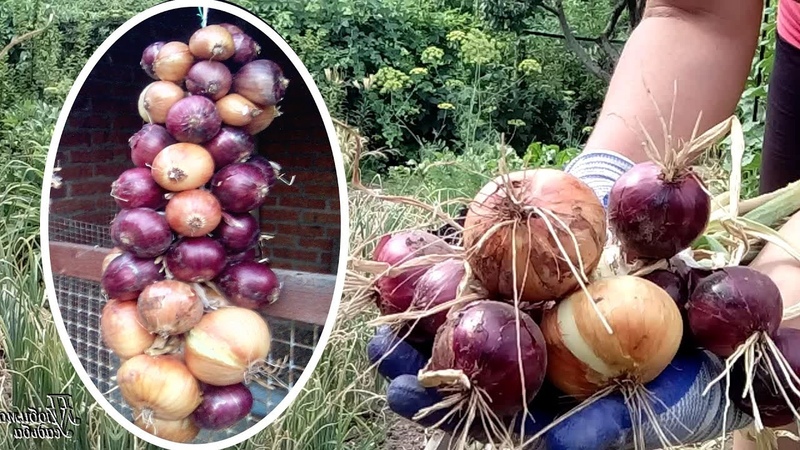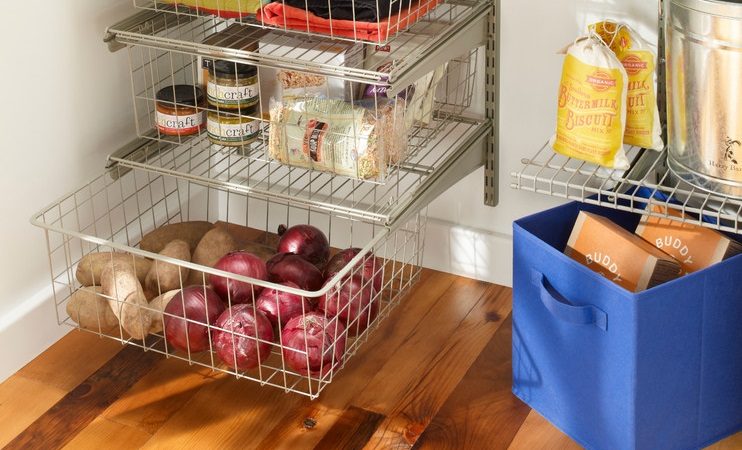How to store onions correctly: at what temperature and in what conditions
Everyone knows how useful onion is and how much vitamins it contains. Summer is coming to an end, summer residents harvest and think about how to save this vegetable until next year. It is not difficult to save it, the main thing is to know the peculiarities and nuances of storage.
The content of the article
How to prepare onions for storage
Proper preparation for harvesting is required for the safety of the onion. The preparation rules are simple, but they will help in preserving the harvest.
- To begin with, stop watering a month before harvesting, so that during storage the vegetables do not begin to rot from excess moisture.
- Harvested only after the stems are dry and settle to the ground.
- Cleaning is carried out in dry weather.
- The bulbs are removed from the ground carefully, without damaging them.
- Be sure to dry the onions after harvesting for several days. This can be done by spreading it out in the garden, and if the weather does not allow, then in a dry, bright place with good ventilation. With good drying, the vegetable will be stored for a long time and will not rot.
- After a few days, check the neck of the bulb. It should be dry and the bulb itself solid.
- Cleanse excess scales, cut roots and stems... If you do not braid, then leave the stems at least 5 cm.
After all these actions, you can harvest the crop for long-term storage.
What conditions are required for storing onions
When the crop is harvested and prepared, care must be taken to provide it with conditions for long-term storage. If you do not think over this stage, the harvest will not last longer than a couple of weeks, its quality and the amount of preserved onions will decrease.

Optimal
The optimum temperature is from +2 to + 5 ° С. This temperature is easier to maintain in a basement or cellar.
Try to maintain humidity at the same level, no more than 75%. High humidity provokes germination and rotting of onions, and from a low head they will dry out.
Darkness and sun protection will be the most suitable condition.
The storage room must be constantly circulating air. If the air stagnates, it will not work for a long time.
Minimum allowable
If you do not have a cellar or basement, then you can store the crop in a living room at a temperature not exceeding 18 ° C. This vegetable also tolerates room storage well, but then fluctuations in humidity and temperatures, which are inevitable when turning on and off central heating, should not be allowed.
If it is impossible to ensure darkness in the room, then at least exclude direct sunlight from entering the storage area.
If there is no ventilation in the room, ventilate it regularly.
Be sure to periodically inspect the bulbs and remove any that start to deteriorate.
What problems can you face during storage
every summer resident wants not only to harvest the crop, but also to preserve it as long as possible. There may be some problems during storage that can be avoided by knowing about them.

Why onions can rot
Many people face this problem. There are several factors that can cause rotting:
- Improper cleaning. If the bulbs were mechanically damaged and not removed from the mass, the affected area can become a source of disease. In this case, healthy vegetables next to it will suffer.
- Storage conditions. If the room temperature changes, it can cause condensation to form, which promotes rotting. At high temperature and humidity, the onions begin to sprout and rot. If the temperature is too low, the bulbs freeze and, when thawed, also begin to rot.
- Selection of varieties... If you are going to grow a large crop, then for long-term storage, choose late-ripening varieties with increased keeping rates.
If you have already noticed that the onion has begun to rot, it is recommended to sort it out, remove all excess scales, dry it again if possible and ventilate the room in which it is stored.
You can additionally sprinkle the bulbs with crushed chalk, which will absorb unnecessary moisture. Take 200 g of chalk per 10 kg of onion.
What to do if midges appear over the onion
Onion gnats can appear from improper storage of various foods, including onions. For a person, they are not harmful, but the neighborhood with them is unpleasant in any case. It is not difficult to distinguish them from other insects, they are small in size, from 1 to 3 mm, and have a yellow-brown color.
Important! They begin to fight them as soon as you notice the first midge. They multiply in a few days and immediately move to other perishable vegetables and fruits, cereals, pots with indoor plants, and also sweets.
There are several ways to deal with onion gnats:
- First of all, be sure to sort out all the onions and discard the spoiled vegetables.
- Use sticky fly traps.
- Put pine needles or cotton wool soaked in essential oil next to the onion.
- Put an open bottle of unfinished wine or sweet drink into which the midges will flock. Then close it and throw it away.
- Midges do not tolerate the smell of camphor, garlic or cloves. Spread garlic cloves nearby or heat some camphor in a frying pan, making a kind of "fumigation".
The onion began to sprout
There are several reasons why onions sprout during storage:
- when spring comes, natural processes are activated;
- storage in a warm room with high humidity;
- the thick neck of the bulb can contain a lot of moisture, which also promotes germination.
At the first sign of sprouting, move the bulbs to a lower temperature room, this will slow down the growth process or stop it altogether.
Attention! Not peel onions from scales, in this form it quickly leaves the dormant state and germinates.
If you store onions in cardboard boxes with a closed lid, a favorable microclimate is formed there, thanks to which the onions are stored longer and do not germinate.
Storage methods

Where and how to store onions depends on their quantity and on your capabilities. Regardless onion varieties need dry and cool air with moderate humidity.
Important! Under no circumstances store onions in plastic bags, in which they begin to rot after a few days due to the lack of air exchange and the formation of a favorable environment for the growth of bacteria.
Cellar
If you decide to store onions in the cellar, prepare boxes or bags in advance in which you will put the onions.
- You can put onions in cardboard or wooden boxes with holes, about 50 cm high. Do not use the boxes above, the lower layers can quickly start to deteriorate. The box should stand on a hill so as not to touch the walls and floor. Place paper or newspaper on the bottom of the drawer, which will absorb moisture.
- Choose bags or nets from a strong material, placing 10-15 kg of onions there.
- Egg containers. This unusual method is also suitable for storage, here you can arrange each onion into a separate recess.
- Nylon stockings. They are very breathable: the bulbs placed there will be well stored.
- Spit. Convenient and beautiful storage method. Heads with a stem of at least 15 cm are used; for convenience, it is better to choose bulbs of the same size.Braids can be hung both in the cellar and at home.
To eliminate excess moisture in the cellar, it is recommended to put containers with ash and not throw away crumbling onion husks, which, like ash, absorb excess moisture.
At home

If you do not have a cellar for storing vegetables, apartment conditions are quite suitable.
- The most important thing is choosing a suitable storage location. It should be cool and dry and located away from various heating appliances.
- Be sure to circulate air in the room.
- Avoid direct sunlight, this will dry out the bulbs.
- The best storage space will be in the pantry, but in this case it is necessary to limit the proximity to carrots, beets or potatoes. It is best to place the onion closer to the garlic.
- You can store onions on the balcony only until the onset of cold weather, in winter it will freeze there. In addition, temperature drops on the balcony are more noticeable than in the apartment, and this will not do the bow to the advantage. If you have an insulated balcony specially designed for storing vegetables, this is fine.
- For daily use, keep some onions in a drawer in the kitchen, nothing will happen to it for a week and a half.
- It is not recommended to store in the refrigerator.
Tips & Tricks
Gardeners have empirically identified which varieties of onions are stored longer, retain their appearance and taste.
- So, for example, red salad onions quickly deteriorate and rot. Therefore, it is better not to leave it for long-term storage, but to eat it first.
- Regular onions, familiar to us, can be stored longer than other varieties, since they have a dense outer shell. In addition, it is unpretentious when grown.
The method of planting onions also affects the shelf life. Onions grown from sets will be stored longer. For these reasons, planting onions with seeds is not recommended.

The variety also affects the storage duration.
- the most "vigorous" onion is more resistant to various diseases and rotting;
- a sweeter vegetable, on the contrary, is stored less and is easily amenable to diseases.
Also, first of all, it is recommended to eat those bulbs that are smaller than others in size, they deteriorate faster.
Conclusion
Onions in general do not require much maintenance. The main thing is to properly prepare it for storage, maintain the required temperature and humidity in the room, and be sure to periodically inspect the crop to identify spoiling bulbs. These recommendations will help preserve the harvest and enjoy the beneficial properties of onions throughout the winter.